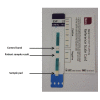Point-of-care detection of lipoarabinomannan (LAM) in urine for diagnosis of HIV-associated tuberculosis: a state of the art review
- PMID: 22536883
- PMCID: PMC3423001
- DOI: 10.1186/1471-2334-12-103
Point-of-care detection of lipoarabinomannan (LAM) in urine for diagnosis of HIV-associated tuberculosis: a state of the art review
Abstract
Detection of Mycobacterium tuberculosis antigens in urine is attractive as a potential means of diagnosing tuberculosis (TB) regardless of the anatomical site of disease. The most promising candidate antigen is the cell wall lipopolysaccharide antigen lipoarabinomannan (LAM), which has been used to develop commercially available enzyme-linked immunosorbent assays. Although highly variable diagnostic accuracy has been observed in different clinical populations, it is now clear that this assay has useful sensitivity for diagnosis of HIV-associated TB in patients with advanced immunodeficiency and low CD4 cell counts. Thus, this assay is particularly useful when selectively used among patients enrolling in antiretroviral treatment services or in HIV-infected patients requiring admission to hospital medical wards. These are the very patients who have the highest mortality risk and who stand to gain the most from rapid diagnosis, permitting immediate initiation of TB treatment. A recently developed low-cost, lateral-flow (urine 'dip-stick') format of the assay provides a result within 30 minutes and is potentially a major step forward as it can be used at the point-of-care, making the possibility of immediate diagnosis and treatment a reality. This paper discusses the likely utility of this point-of-care assay and how it might best be used in combination with other diagnostic assays for TB. The many further research studies that are needed on this assay are described. Consideration is particularly given to potential reasons for the variable specificity observed in existing field evaluations of LAM ELISAs. Whether this might be related to the assay itself or to the challenges associated with study design is discussed.
Figures




References
-
- World Health Organization. Global tuberculosis control 2011. Accessed on 21.12.11 at: http://www.who.int/tb/publications/global_report/en/index.html
Publication types
MeSH terms
Substances
Grants and funding
LinkOut - more resources
Full Text Sources
Other Literature Sources
Medical
Research Materials

